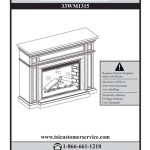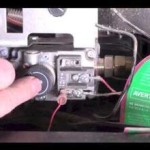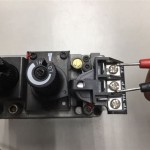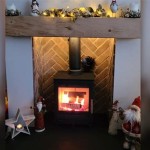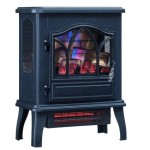Use bullet points for listing any points.
Fireplace Insert Blowers: Maximizing Heat Efficiency and Comfort
Fireplace inserts are designed to enhance the efficiency and aesthetic appeal of traditional fireplaces. By sealing off the existing firebox and providing a controlled combustion environment, inserts offer improved heat output and reduced emissions. However, even the best fireplace insert can benefit from an additional component: a blower. A fireplace insert blower, also known as a fan, is a device designed to circulate warm air produced by the insert throughout the room and, in some cases, throughout the entire house. This article will explore the functionalities, benefits, selection criteria, and maintenance of fireplace insert blowers, providing a comprehensive understanding of their role in home heating.
A fireplace insert blower is typically installed within the insert itself, often at the rear or underneath the firebox. Its primary function is to draw cooler air from the room, pass it across the heated surfaces of the insert, and then discharge the warmed air back into the room. This forced convection process significantly increases the rate at which heat is distributed, preventing the heat from simply rising to the ceiling above the fireplace. Without a blower, much of the generated heat may remain localized near the fireplace, leaving other areas of the room, or adjacent rooms, significantly cooler.
Key Benefits of Using a Fireplace Insert Blower
The integration of a blower into a fireplace insert system offers several distinct advantages, contributing to improved heating performance, energy efficiency, and overall comfort.
- Enhanced Heat Distribution: The most significant benefit is the ability to distribute heat more evenly throughout the room. A blower forces the warm air to circulate, eliminating cold spots and creating a more consistent temperature across the space. This is particularly important in larger rooms or open-concept living areas where natural convection alone may be insufficient.
- Increased Heating Efficiency: By actively circulating warm air, a blower allows the insert to heat the room more quickly and efficiently. This means the insert doesn't have to burn as much fuel (wood, gas, or pellets) to achieve the desired temperature, resulting in potential fuel cost savings.
- Improved Comfort: The consistent and even heat distribution provided by a blower contributes to a more comfortable living environment. Eliminating cold spots and drafts creates a more inviting and enjoyable space, especially during colder months.
- Reduced Surface Temperatures on the Insert: By constantly moving air across the hot surfaces of the insert, the blower can help to reduce the surface temperature. This can be a safety benefit, especially for homes with small children or pets, minimizing the risk of accidental burns from touching the hot surface.
Selecting the Right Fireplace Insert Blower
Choosing the appropriate blower for a fireplace insert is crucial for optimal performance and longevity. Several factors should be considered during the selection process.
Insert Compatibility: The most critical factor is ensuring that the blower is compatible with the specific fireplace insert model. Manufacturers often design blowers specifically for their inserts, ensuring proper fit, airflow, and electrical connections. Check the insert's owner's manual or contact the manufacturer to determine compatible blower models. Using an incompatible blower can lead to reduced performance, overheating, or even damage to the insert or blower.
Airflow Capacity (CFM): Airflow is measured in Cubic Feet per Minute (CFM) and indicates the volume of air the blower can move. A higher CFM rating generally means the blower can distribute more heat. The appropriate CFM rating depends on the size of the area to be heated, the insert's heat output, and the building's insulation. Consulting the insert's specifications or seeking professional advice can help determine the optimal CFM rating for the application.
Noise Level: Blower noise can be a significant consideration, especially in living rooms or bedrooms where quiet operation is desired. Look for blowers with low noise ratings, typically measured in decibels (dB). While some noise is inevitable, higher-quality blowers often incorporate design features like vibration dampening and optimized fan blades to minimize noise levels.
Speed Control: Many fireplace insert blowers offer variable speed control, allowing users to adjust the airflow and heat output to suit their preferences and the current heating needs. A variable speed control can also help to reduce noise levels when maximum airflow is not required.
Automatic Operation: Some blowers are equipped with automatic temperature sensors that activate the blower when the insert reaches a certain temperature and automatically turn it off when the insert cools down. This feature provides hands-free operation and ensures that the blower only runs when it is needed, maximizing energy efficiency and prolonging the blower's life.
Ease of Installation and Maintenance: Consider the ease of installation and maintenance requirements when selecting a blower. Some blowers are designed for simple DIY installation, while others may require professional installation. Regular maintenance, such as cleaning the blower blades and housing, is essential for optimal performance and longevity.
Power Consumption: While most fireplace insert blowers consume relatively little electricity, it is worth considering the power consumption, especially if the blower will be used frequently. Look for energy-efficient models that minimize power consumption without sacrificing performance.
Warranty: A comprehensive warranty provides peace of mind and protection against potential defects or malfunctions. Check the warranty terms and conditions before purchasing a blower.
Maintaining a Fireplace Insert Blower for Optimal Performance
Regular maintenance is crucial for ensuring the optimal performance and extending the lifespan of a fireplace insert blower. Neglecting maintenance can lead to reduced airflow, increased noise, and even premature failure of the blower motor.
Regular Cleaning: Dust and debris can accumulate on the blower blades and within the blower housing, reducing airflow and increasing noise. The blower should be cleaned regularly, ideally at least once per year, or more frequently if it is used extensively. To clean the blower, first, disconnect the insert from the power source. Then, carefully remove the blower from the insert, following the manufacturer's instructions. Use a soft brush or vacuum cleaner to remove dust and debris from the blower blades and housing. Avoid using harsh chemicals or solvents that could damage the blower motor or other components.
Lubrication (If Applicable): Some blower motors require periodic lubrication. Check the manufacturer's instructions to determine if lubrication is necessary and, if so, what type of lubricant to use. Use only the recommended lubricant to avoid damaging the motor.
Inspect Wiring and Connections: Regularly inspect the wiring and electrical connections to ensure they are secure and free from damage. Loose or damaged wiring can cause electrical problems and potentially pose a safety hazard.
Check for Obstructions: Ensure that there are no obstructions blocking the airflow to or from the blower. Obstructions can reduce airflow and cause the blower to overheat.
Professional Inspection: Consider having a qualified technician inspect the blower and the entire fireplace insert system periodically, especially if you notice any unusual noises, reduced airflow, or other performance issues. A professional inspection can identify potential problems before they become major issues.
By following these maintenance guidelines, homeowners can ensure that their fireplace insert blowers continue to operate efficiently and effectively for many years, maximizing the heat output of their fireplace inserts and maintaining a comfortable and energy-efficient home.

Why Should I Get A Fireplace Blower For My Masonry

Pleasant Hearth Circulating Blower For Zero Clearance Ventless Dual Fuel Fireplace Inserts Zcb100 The Home Depot

Ventis Wood Burning Fireplace Insert With Blower Hei170 Hvacdirect Com

Inserts Wood Osburn 2000 Insert With Blower Ob02024

35 Ruby Contemporary Intellifire Touch Direct Vent Fireplace Insert Blower And Remote Electronic Ignition Majestic

Inserts Wood Osburn 2200 Insert With Blower Ob02201

35 Ruby Traditional Intellifire Touch Direct Vent Fireplace Insert Blower And Remote Electronic Ignition Majestic

How To Replace Your Rsf Fireplace Blower Fan

Ventis Hei240 Wood Burning Insert

Pin By Guillermo Adolfo Otero Salazar On Fireplaces Fireplace Heat Blower Grate
Related Posts

